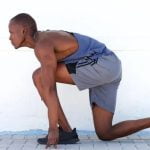The Presidential Fitness Test, a longstanding initiative in the United States aimed at promoting physical fitness among youth, has played a significant role in shaping the health and wellness of generations. Designed to assess and encourage physical activity, the test has been an essential tool in promoting overall health and well-being among students.
What were the exercises of the presidential fitness test? Push-ups, sit-ups, and the mile run were among the components that challenged participants to showcase their strength, endurance, and cardiovascular fitness levels. These exercises not only provided a measure of physical aptitude but also instilled discipline and motivation to maintain an active lifestyle.
Through its history, the Presidential Fitness Test has evolved to keep pace with changing societal attitudes towards health and fitness. From its inception to present times, the test has reflected advancements in exercise science and tailored its standards to address modern challenges in combating sedentary lifestyles.
The next sections will delve deeper into the significance of fitness testing, changes in the test over time, specific exercises involved, standards for passing, impacts on youth fitness levels, criticisms faced, and its lasting legacy on promoting physical activity.
Importance of Fitness Testing
Fitness testing, such as the Presidential Fitness Test, plays a crucial role in promoting overall health and well-being. By assessing various aspects of physical fitness, these tests provide individuals with valuable information about their current fitness levels and areas that may need improvement.
The results can serve as a motivating factor for individuals to set specific fitness goals and work towards achieving them. Moreover, fitness testing can also serve as a preventive measure by identifying potential health risks early on.
There are numerous benefits to participating in fitness testing like the Presidential Fitness Test. One of the key advantages is that it helps individuals track their progress over time. By regularly undergoing fitness assessments, individuals can monitor improvements in their strength, endurance, flexibility, and cardiovascular health. This tracking mechanism not only provides motivation but also helps individuals stay accountable to their fitness goals.
The exercises included in the Presidential Fitness Test are specifically designed to assess different aspects of physical fitness. The test typically includes exercises such as push-ups, sit-ups, and the mile run. Each exercise targets different muscle groups and cardiovascular capabilities, providing a comprehensive assessment of an individual’s overall physical readiness.
By incorporating a variety of exercises into the test, participants are able to showcase their strengths in different areas while also identifying areas that may require improvement. Through this holistic approach to fitness testing, individuals can gain a better understanding of their overall physical health and take proactive steps towards improving it.
- Push-Ups
- Sit-Ups
- The Mile Run
Evolution of the Presidential Fitness Test
The Presidential Fitness Test, now known as the Presidential Youth Fitness Program, has undergone significant changes throughout its history. Originally introduced in 1956 by President Dwight D. Eisenhower as the Youth Fitness Test, its primary goal was to improve the physical fitness of American youth amidst growing concerns about sedentary lifestyles. Over the years, the test evolved to adapt to changing fitness standards and promote a more holistic approach to health and wellness.
One of the most notable changes in the evolution of the Presidential Fitness Test was the shift from a narrow focus on performance-based assessments to a more comprehensive evaluation of overall health and fitness. While the original test primarily consisted of exercises like push-ups, sit-ups, and the mile run, later versions incorporated measurements such as flexibility, agility, and cardiovascular endurance.
This change reflected a broader understanding of fitness that encompassed not just physical strength but also flexibility, balance, and coordination.
Moreover, with increased awareness of individual differences in fitness levels and abilities, the Presidential Fitness Test transitioned towards promoting personal improvement rather than competition. The emphasis shifted towards encouraging students to set personal goals for their own health and well-being rather than simply aiming to meet standardized benchmarks. This shift aimed to foster a positive mindset towards exercise and physical activity among young people, promoting lifelong habits of staying active and prioritizing personal fitness goals.
| Presidential Fitness Tests Exercises | Descriptions |
|---|---|
| Push-ups | This exercise measures upper body strength by counting how many push-ups an individual can complete in a given time. |
| Sit-ups | Sit-ups assess core strength by measuring how many repetitions an individual can do within a set timeframe. |
| Mile Run | This cardiovascular endurance test evaluates how quickly someone can run one mile. |
Exercises of the Presidential Fitness Test
The Presidential Fitness Test, introduced in the 1960s by President Kennedy, aimed to promote physical activity and highlight the importance of fitness among American youth. The test was designed to assess students’ overall physical health through a series of exercises that tested strength, endurance, and cardiovascular fitness. One of the key components of the test was measuring individual performance and progress in areas such as push-ups, sit-ups, and the mile run.
Push-ups were included in the test to evaluate upper body strength and endurance. Students were required to perform as many push-ups as possible within a certain time frame to demonstrate their arm and chest strength. Sit-ups assessed core abdominal strength and muscular endurance. Participants had to complete a designated number of sit-ups correctly within a specified time limit to pass this portion of the test.
Another significant exercise in the Presidential Fitness Test was the mile run, which tested cardiovascular fitness and endurance. Students were timed while running a mile distance, with their completion times determining their performance level. The mile run aimed to evaluate participants’ aerobic capacity and overall cardiovascular health. These exercises provided a comprehensive assessment of students’ physical fitness levels and helped promote an active lifestyle among young people.
| Exercise | Purpose |
|---|---|
| Push-Ups | Assess upper body strength and endurance |
| Sit-Ups | Evaluate core abdominal strength and muscular endurance |
| Mile Run | Test cardiovascular fitness and endurance |
Fitness Standards
The Presidential Fitness Test, which was introduced in the 1960s by President Lyndon B. Johnson, aimed to promote physical fitness and healthy lifestyles among American youth. This test consisted of a series of exercises that participants needed to complete in order to pass and receive a certificate recognizing their achievement. The fitness standards set by the test were not only challenging but also served as a benchmark for assessing the overall health and fitness levels of individuals.
To pass the Presidential Fitness Test, participants needed to meet certain criteria for each exercise component. One of the key exercises included push-ups, which tested upper body strength and endurance. Participants were required to complete a specific number of push-ups within a set time frame based on their age and gender.
Sit-ups were another component of the test that assessed core strength and muscular endurance. Similar to push-ups, participants had to perform a certain number of sit-ups according to their age group.
In addition to push-ups and sit-ups, participants also had to complete a timed one-mile run as part of the Presidential Fitness Test. This exercise focused on cardiovascular endurance and overall fitness levels.
The goal was to finish the mile run within a specified time based on age and gender categories. Meeting these rigorous fitness standards not only demonstrated an individual’s physical capabilities but also encouraged them to strive for better health and fitness outcomes in the long run.
Impact of the Fitness Test
The Presidential Fitness Test, originally introduced by President Lyndon B. Johnson in the 1960s, has had a significant impact on youth fitness levels and overall health in the United States. By implementing a standardized test to assess physical fitness among students, the program aimed to encourage young people to lead active and healthy lifestyles. The test consisted of various exercises that challenged participants to demonstrate their strength, endurance, and cardiovascular fitness.
Exercises of the Presidential Fitness Test
One of the key components of the Presidential Fitness Test was assessing upper body strength through push-ups. Students were required to perform as many push-ups as possible within a set amount of time. In addition, sit-ups were included in the test to measure core strength and abdominal muscle endurance. Participants had to complete a certain number of sit-ups within a specific timeframe to meet the standards set by the test.
Another exercise that was part of the Presidential Fitness Test was the mile run, which assessed cardiovascular endurance and overall fitness levels. Students were timed as they ran one mile, with their performance compared to established standards for their age and gender. This portion of the test emphasized the importance of aerobic exercise and highlighted the benefits of cardiovascular health.
Overall, the exercises included in the Presidential Fitness Test aimed to provide a comprehensive assessment of students’ physical fitness levels. By challenging young people to improve their strength, endurance, and overall health, the test played a crucial role in promoting physical activity and encouraging healthy habits among youth across the country.
Criticisms of the Test
The Presidential Fitness Test has long been a subject of both praise and criticism within the realm of physical education. While the test was initially designed with good intentions to promote physical activity and highlight the importance of fitness, it has faced its fair share of challenges and criticisms over the years. One major critique of the test is its narrow focus on specific exercises, which may not be fully representative of an individual’s overall fitness level.
Lack of Comprehensive Assessment
One common criticism of the Presidential Fitness Test is that it does not provide a comprehensive assessment of an individual’s overall health and fitness. The test primarily focuses on a few key exercises, such as push-ups, sit-ups, and the mile run, which may not accurately reflect an individual’s strength, flexibility, cardiovascular endurance, or other important components of fitness.
Critics argue that relying solely on these exercises may overlook other areas that are critical for overall well-being.
Impact on Self-Esteem
Another criticism of the Presidential Fitness Test is related to its potential impact on students’ self-esteem. For some individuals who struggle with certain exercises or do not meet the established standards for passing the test, this experience can be demoralizing and have negative effects on their self-confidence. This can perpetuate feelings of inadequacy or contribute to a sense of failure in physical fitness, rather than fostering a positive relationship with exercise and health.
Socioeconomic Disparities
There have also been concerns raised about how the Presidential Fitness Test may exacerbate socioeconomic disparities in access to resources and opportunities for physical activity. Students from low-income communities or schools with limited resources may face additional challenges in meeting the standards set by the test due to factors such as lack of access to sports facilities, proper equipment, or trained coaches. This disparity can further widen existing gaps in health outcomes between different socioeconomic groups.
The Legacy of the Presidential Fitness Test
The Presidential Fitness Test has left a lasting impact on the promotion of physical activity among youth in the United States. Through its history and evolution, the test has highlighted the importance of fitness testing for overall health. The specific exercises included in the test, such as push-ups, sit-ups, and the mile run, have not only served as benchmarks for physical fitness but have also encouraged individuals to strive for a higher level of health and wellness.
By establishing fitness standards that participants needed to meet in order to pass the test, the Presidential Fitness Test has provided a tangible goal for individuals to work towards. The test has helped instill a sense of discipline and motivation in those who participated, emphasizing the significance of regular exercise and physical activity. Additionally, by setting these standards, the test has contributed to improving youth fitness levels across the nation.
While criticisms and controversies may have arisen regarding the Presidential Fitness Test over the years, its legacy remains significant. The test has paved the way for discussions on fitness testing and its role in promoting a healthy lifestyle. By encouraging individuals to engage in regular physical activity and maintain good health practices from a young age, the test continues to influence generations in their pursuit of overall wellness and physical fitness.
Frequently Asked Questions
What Are the 6 Exercises on the Presidential Fitness Test?
The six exercises included in the Presidential Fitness Test are the 50-yard dash, pull-ups or a flexed arm hang, sit and reach, shuttle run, curl-ups, and a one-mile run.
What Did the Presidential Fitness Test Consist Of?
The Presidential Fitness Test consisted of assessing students’ physical fitness levels through a series of exercises measuring cardiovascular endurance, muscular strength, flexibility, and overall physical health.
What Are the Exercises for the President’s Challenge?
The exercises for the President’s Challenge were similar to those on the Presidential Fitness Test but were updated to include activities such as aerobic exercise routines like walking or dancing along with nutrition education components to promote healthy lifestyles.

Passionate about providing useful information to anyone with an interest in the field of Personal Training, I strive to pass on to our readers quality information and to answer any questions about Personal Trainers, the work they do and how to become one.





